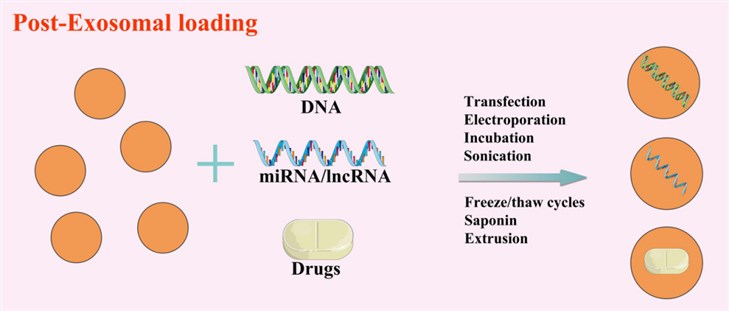Exosome Cargo Post-loading Service
Overview Services Features FAQs
Further benefits can be achieved by loading molecules of interest on unmodified exosomes. Creative Biolabs specializes in providing a tailored post-loading service to realize the desired cargo loading to exosomes.
Introduction of Post-loading Strategy
After isolating the exosomes, it is a more common strategy to load exosomes with therapeutic products. This is caused by the process's simplicity as well as the fact that loading efficiency is higher than with the pre-loading approach. There are two types of post-loading techniques: passive loading and active loading. Passive loading is the process of incubating exosomes with therapeutic cargo such that it can be passively loaded into the exosomes. Active loading necessitates disruption of the exosomal membrane, which is often accomplished through electroporation or the incorporation of surfactants.
 Fig.1 Several machineries involved in the biogenesis of exosomes.1
Fig.1 Several machineries involved in the biogenesis of exosomes.1
Post-Loading Methods at Creative Biolabs
The payload to be loaded is incubated with the separated and refined exosomes. The cargo is going to diffuse into the exosomes because of the concentration gradient.
The exosomes are submerged in a conductive fluid and exposed to an electric field during the electroporation process. The phospholipid bilayer of exosomes is rearranged by the applied current, creating tiny holes in the membrane. Drugs and/or nucleotides diffuse into the exosomes' interiors as a result of these holes. Generally, electroporation is the primary method of choice for encapsulating nucleotides.
This technique uses ultrasonic frequencies to agitate the particles in the suspension. The payload and exosomes are mixed, and the probe sonicator causes the nanovesicles' plasma membrane to distort. When the membrane deforms, the drug diffuses inside the exosomes.
This procedure involves incubating the payload with the exosomes. They were then promptly frozen at -80 °C and thawed at ambient temperature. Repeat the cycle several times and in each cycle, the plasma membrane is destroyed, allowing the drug molecules to diffuse in the exosomes.
-
Saponin Assisted Incubation
In this method, exosomes are incubated with cargo and saponin. Compared with simple incubation, this increase in permeability makes the loading of hydrophilic molecules easier.
 Fig.2 Exosomes can be modified by post-loading methods.2
Fig.2 Exosomes can be modified by post-loading methods.2
Technical Advantages
Among many post-loading strategies, the use of active loading is a more efficient means. At present, for the post-loading strategy of exosomes, Creative Biolabs provides methods of electroporation or chemical reagent transfection. Our technical advantages are:
-
Mature technology platform and professional staffing;
-
There are no restrictions on cell types, and the cargo loading rate can be calculated and evaluated;
-
Short development cycle and low cost.
The source of exosomes and cargo loading methods are important factors that affect their use as drug carriers. Creative Biolabs has been making efforts to provide diverse and high-end exosome research services. At present, there are many ways to load cargo in exosomes, and our researchers have been looking for new and improved methods in addition to the existing technical means. Please feel free to contact us if you needed.
FAQs
Q: How does the Exosome Cargo Post-loading Service work?
A: The service typically involves the isolation of exosomes, followed by the loading of desired cargo molecules into the exosomes using various methods such as electroporation, incubation, or extrusion, depending on the cargo and the desired outcome.
Q: What types of cargo molecules can be loaded into exosomes?
A: A wide range of cargo molecules can be loaded into exosomes, including but not limited to small molecules, therapeutic proteins, small nucleic acids, and imaging agents for research or therapeutic applications.
Q: Which benefits come with using the Exosome Cargo Post-loading Service?
A: By utilizing this service, researchers and developers can achieve targeted delivery of cargo molecules to specific cells or tissues, enhance the stability and bioavailability of cargo molecules, and potentially reduce off-target effects when compared to other delivery methods.
Q: Are there specific storage or handling requirements for exosomes after cargo loading?
A: Exosomes loaded with cargo molecules may have specific storage or handling requirements to maintain their stability and functionality. Our research scientists will typically provide guidelines on how to store and handle the loaded exosomes to ensure optimal results.
References
-
Rodrigues, Paulo, et al. "An overview of exosomes in cancer therapy: A small solution to a big problem." Processes 8.12 (2020): 1561. Under Open Access license CC BY 4.0, without modification.
-
Xu, Mengqiao, et al. "Recent advancements in the loading and modification of therapeutic exosomes." Frontiers in Bioengineering and Biotechnology 8 (2020): 586130. Under Open Access license CC BY 4.0. The image was modified by extracting and using only a Part of the original image.
For Research Use Only. Cannot be used by patients.
Related Services:

 Fig.1 Several machineries involved in the biogenesis of exosomes.1
Fig.1 Several machineries involved in the biogenesis of exosomes.1
 Fig.2 Exosomes can be modified by post-loading methods.2
Fig.2 Exosomes can be modified by post-loading methods.2








